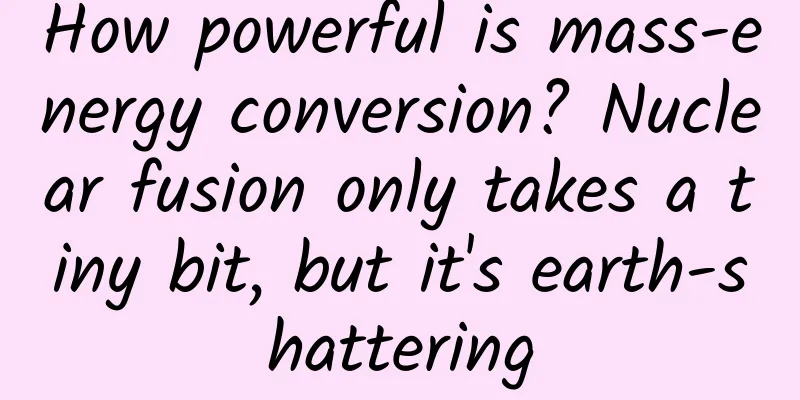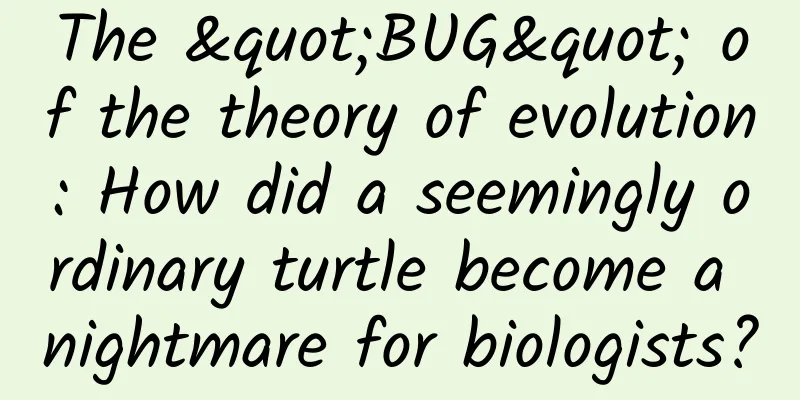How powerful is mass-energy conversion? Nuclear fusion only takes a tiny bit, but it's earth-shattering

|
The highest mass-energy conversion rate that humans have mastered now is nuclear fusion. The energy of a hydrogen bomb explosion is earth-shattering and can destroy the world. This is hydrogen nuclear fusion. In fact, the mass-energy conversion rate of nuclear fusion is extremely small, about 7/1000 of the mass, that is, only 7 grams of one kilogram of matter is converted into energy. Why is it so powerful? This is the power of mass-energy conversion The mass-energy equation was discovered by Einstein more than a hundred years ago and was a huge breakthrough in human understanding of the laws of the universe. The mass-energy equation is a relationship that describes the conversion of mass into energy, or energy into mass. It involves a series of complicated argumentation processes, which we will not list here for the sake of popular science. The final result is very simple and clear, which can be expressed as: E=MC^2. The left side of the formula represents energy, in units of J (joule); the right side represents mass M multiplied by the square of the speed of light C. The unit of mass is kg (kilogram), the unit of speed of light is m (meter), and the standard value of the speed of light in a vacuum is 299792458 m/s (meter/second). If there is no special requirement for accuracy, the speed of light is generally simplified to 300000000 m/s for easier calculation. Although this is such a simple equation, it has brought about a breakthrough in human knowledge. From then on, the law of conservation of mass and energy replaced the previous law of conservation of mass and is more accurate. People know that there is such a huge amount of energy contained in mass. As long as there is a way to convert mass into energy, energy will be inexhaustible. The essence of this equation is equivalent exchange, which means that mass and energy are equivalent. Any substance with the same mass contains the same energy. 1kg of gold, 1kg of dynamite, 1kg of cotton, and 1kg of cabbage all convert into the same amount of energy, which is about 9*10^16J. This energy is equivalent to 25 billion kilowatt-hours of electricity, or the power of an explosion of 21.51 million tons of TNT. For thousands of years, humans have obtained energy through inefficient chemical methods. The energy obtained by burning plants, coal, and fuel oil all belongs to chemical energy, which is obtained through chemical reactions. This efficiency is extremely low. For example, when burning coal, the heat energy obtained by burning 1kg of standard coal is 7000 kcal, which is about 29300962.74592J. This energy is only 0.000000000326 of the mass-energy conversion rate. Therefore, in the textbooks of the past, the law of conservation of mass is basically correct, because the energy consumed can be basically ignored. But after all, there is still a little loss, so the law of conservation of mass is only relatively accurate, not very accurate, and the law of conservation of mass and energy is truly accurate. In the last century, humans discovered nuclear energy, which is a mode of obtaining energy through mass-energy conversion. This is a leap forward for humans to obtain energy, but its conversion rate is also very low. At present, humans know that there is no technology that can convert all mass into energy, except for the annihilation of matter and antimatter. The most powerful nuclear fusion technology can only convert 0.7% of mass into energy. Mass-energy conversion is equivalent, so can energy be converted into matter? Many people often wonder: since mass can be converted into energy, why can't energy be converted into mass? In fact, this understanding is wrong. The conversion of mass and energy is not one-way, but two-way. Energy can also be converted into mass, and the mass-energy equation also applies. The conditions for converting a little bit of mass into energy are extremely harsh and difficult. For example, it takes extreme conditions such as atomic bombs and hydrogen bomb explosions, extremely high temperatures and high pressures, to convert a little bit of mass. And converting energy into mass is even more difficult. You should know that if 1kg of matter is converted into energy, it can produce the equivalent of 25 billion kilowatt-hours of electricity or 21.51 million tons of explosives, which is equivalent to the power of 1,655 Hiroshima atomic bombs exploding at the same time. According to the principle of equivalent exchange, it is necessary to pack all the energy of such a large power into one container without any waste to obtain 1kg of matter. In fact, the conversion of energy into the mass of matter has been happening all the time. Our universe has been a process of converting pure energy into the mass of matter since the moment of the Big Bang 13.8 billion years ago. How did the universe come into being from energy? Modern quantum mechanics believes that before the Big Bang there was no matter, no time and space, only background energy, which is the vacuum zero-point energy, and this energy is extremely huge. This energy is hidden in the void of the vacuum, in the form of quantum foam, which appears randomly in the form of virtual particle pairs and quickly annihilates. If the universe is completely symmetrical and conserved, our universe would not exist, and there would be no humans like us talking nonsense here. In the early years, the theory of parity conservation dominated the physics community. People at that time were very confused. Since matter and antimatter are symmetrical, and matter and antimatter will annihilate at any time, why did the universe exist? Where did the antimatter go now? These questions were not answered until the law of parity non-conservation was published by Chen Ning Yang and Zheng Dao Li. It turns out that the universe is only basically symmetric and conserved, but it is not perfect and has broken symmetries, which leads to non-conservation phenomena. Some of the virtual particle pairs that appear and annihilate at any time do not follow the rules, and a single particle does not annihilate, and a singularity appears. This singularity explodes and continues to expand, and our world appears. According to this theory, we cannot be the only unruly virtual particle, there may be many, many more. This is the basis for the claim that there are many parallel universes outside our universe. As the universe cooled, energy transformed our world At the moment of the big bang, the universe was only energy. At that time, the temperature of the universe was infinitely high and the density was infinitely large, which could not be measured. It was not until the Planck time, which was 10^-43 seconds (one trillion trillion trillion trillionth of a second), that the temperature dropped to 10^32K (a trillion trillion trillion K) and the density dropped to 10^94g/cm^3 (grams per cubic centimeter), which is more than 10^78 times the density of a proton. As the universe expanded at a high speed, the temperature dropped rapidly. 10^-12 seconds (one trillionth of a second) after the Big Bang, the temperature dropped to 10^-15K, and various particles began to appear, including protons, neutrons, bosons, neutrinos, electrons, quarks, and gluons, and they stabilized. This means that the universe has transformed matter from energy, but this matter is still mainly leptons, with very few hadrons. For a long time, the temperature and density of the universe were still extremely high, the nuclear force could not bind neutrons and protons, and even light could not escape, and the universe was in a dark and opaque era. It was not until 380,000 years later, when the temperature of the universe dropped to 3000K, that neutral atoms began to combine and form, and real tangible matter began to appear, mainly the simplest hydrogen and helium atoms, and a very small amount of lithium. These elements floated in the universe and began to condense into nebulae due to their own gravity, and then formed stars and galaxies. At this point, the world we know now appeared, and all of this was transformed from energy. Scientists have simulated the state of the universe one second after the Big Bang In the Large Hadron Collider in Europe, scientists used a powerful energy of 1045 trillion electron volts to push two beams of lead ions towards each other in a 27km underground pipe. When the speed of the two beams of lead ions reached 99.9999991% of the speed of light, they collided, instantly generating a temperature of 10 trillion degrees. A mini version of the Big Bang appeared, restoring the scene one second before the Big Bang, which was a dense "primordial particle soup" composed of quarks and gluons under high temperature and high pressure. This experiment not only confirmed the expectations of the Big Bang theory, but also provided evidence for the conversion of energy into matter. In many experiments at the collider, the conversion of mass and energy strictly conformed to Einstein's mass-energy equation, which further proved the greatness of this theory that has been discovered for more than 100 years. In the human world, the main method used is to convert mass into energy. The conditions for converting mass into energy are very harsh. At present, except for the annihilation of matter and antimatter, there is no technology that can convert all mass into energy. The technology with the highest mass-energy conversion rate that humans can master now is nuclear fusion technology. Humans mastered the technology of nuclear fission and nuclear fusion in the last century, but until now, the controllability of this technology has remained limited to nuclear fission. Therefore, it can be used for civilian purposes, such as nuclear power generation, and has played a significant role in solving energy problems for mankind. Apart from the "boom" of a hydrogen bomb explosion, nuclear fusion cannot achieve a slow and controllable release of energy. Only by achieving a controlled and slow release can it be promoted to civilian use and benefit society. Nuclear fission is the process of splitting a heavy nucleus into smaller nuclei. During the fission process, a portion of mass is lost. The amount of this loss is very small, theoretically less than 0.1%. Currently, nuclear fission technology mainly uses two raw materials, uranium 235 and plutonium 239. The mass loss of uranium 235 during fission is about 0.0946%, and the loss of plutonium 239 is about 0.0961%. Nuclear energy is currently the most efficient mass-energy conversion technology in the world. Although less than 0.1% of the mass of 1 kg of uranium or plutonium is converted into energy by fission, this energy is incomparable to the chemical energy of mankind in the past. According to Einstein's mass-energy equation, 1 kg of nuclear fission fuel converts about 1g of energy, which is 9*10^13J, which is equivalent to 25 million kilowatt-hours of electricity, or the explosion energy of 25,150 tons of dynamite. Of course, this is only the efficiency of perfect conversion in theory. In actual operation, this efficiency cannot be achieved. This is because the fuel cannot reach 100% purity, nor can it achieve 100% complete fission reaction. For example, when an atomic bomb explodes, it will explode before the fission reaction is complete. According to some information, the actual efficiency of the Hiroshima atomic bomb was only 1.2%, which is the reason. The efficiency of nuclear fusion is much higher than that of nuclear fission. The sun and all stars can continuously radiate energy because of the continuous nuclear fusion in their cores. Since nuclear fusion requires extremely high temperature or high pressure, how to control the nuclear fusion energy in a container and release it slowly and continuously is still a difficult problem being studied all over the world. Why is nuclear fusion called “artificial little sun”? This is because nuclear fusion imitates the way the sun converts mass into energy, so people call controlled nuclear fusion "artificial little sun". But please understand that artificial little sun is not to create a shining little sun to shine on the world, but to use the nuclear fusion method in the core of the sun to obtain energy for power generation or power to benefit mankind. In fact, the artificial sun is just a huge machine called a tokamak device (see the picture above), and the nuclear fusion reaction is controlled inside this machine. There are two biggest challenges to be solved in controlled nuclear fusion. One is to confine the high temperature of billions of degrees in a cage, and no material in the world can withstand such high temperature. Currently, the main methods used to confine high temperature plasma for nuclear fusion are magnetic confinement and inertial confinement. I have talked about this many times in the past, so I will not go into details this time. Another difficulty is the ratio of energy input to output. This technology is only valuable when the output is a certain order of magnitude greater than the input. Ignition of nuclear fusion requires a very high ignition temperature, which also requires a large input of energy. If the input energy is greater than the output energy, or only slightly less, it will be of little value. Now these two difficulties are being overcome, and all countries have made considerable progress. In this field, China is at the forefront of the world. The temperature and time of confining nuclear fusion high-temperature plasma are constantly extending, and now a breakthrough of confinement of 120 million degrees for 101 seconds has been achieved. However, this indicator is obviously still a long way from the true commercial application of controlled nuclear fusion. The nuclear fusion energy conversion rate is still very low. Will it be higher in the future? The heavier the element, the more stringent the nuclear fusion conditions are. For example, the temperature of helium nuclear fusion must be at least 200 million degrees. Therefore, controlled nuclear fusion can only start from the lightest element - hydrogen, because this type of fusion requires the lowest temperature conditions. Controlled hydrogen nuclear fusion on Earth, in layman's terms, is the process of hydrogen nuclei continuously fusing into heavier helium nuclei at a temperature of 100 million degrees Celsius. In this process, 0.7% of the mass is converted into energy, which is 6 times higher than the mass-energy conversion rate of nuclear fission. That is to say, 7g of 1kg of hydrogen is converted into energy. According to the mass-energy equation, 6.3*10^14J of energy can be obtained. This energy is equivalent to 175 million kilowatt-hours of electricity, or the power of 150,000 tons of TNT. Of course, nuclear fusion, like nuclear fission, is affected by many factors, and its efficiency will not reach 100% perfectly. But no matter what, this is the most efficient mass-energy conversion that humans can master now. From 0.7% to 100% mass-energy conversion rate, there is still a 99.3% gap waiting for human beings to discover. In the future, can human beings find a more efficient mass-energy conversion method? I don't know. But what is certain is that the higher the mass-energy conversion rate, the higher the conversion conditions. I believe that as human science continues to develop, there will always be new breakthroughs. The most perfect mass-energy conversion is the collision of antimatter and matter. The annihilation of 1kg of antimatter and 1kg of matter can convert 2kg of mass-energy. However, antimatter is very rare in our world. Scientists have spent huge amounts of energy on experiments for decades, but the total amount of antimatter particles (protons and atoms) obtained in the world is only 15ng (nanograms). If all of them were annihilated, it would not be enough to boil a cup of water. Of course, it is fortunate that there is very little antimatter in our world, otherwise if terrorists could just get some, humans would not be able to survive. What do you think? Welcome to discuss, thank you for reading. The copyright of Space-Time Communication is original. Infringement and plagiarism are unethical behavior. Please understand and cooperate. |
<<: Astra: Fight again and again despite repeated failures, so what if the rocket flies
Recommend
Face ID and under-screen fingerprint, Apple's paranoia and Android's tolerance
The dominance of the iPhone seems to be broken, b...
After 4 days of high fever, a 3-year-old child was diagnosed with "white lungs"! Why is mycoplasma pneumonia so aggressive? How to prevent it?
Recently, the incidence of mycoplasma pneumonia i...
CCFA: China Instant Retail Development Report 2022
In recent years, instant retail has developed rap...
What's the difference of 2,000 yuan? A comprehensive comparison between iPhone SE and iPhone 6S
The iPhone SE was released again with all the spo...
Uber-ized future business: From control economy to negotiation economy
A cooler job than Internet product manager, Wall ...
Brave New World Unreachable How difficult is it to make a VR movie?
Decades have passed, and virtual reality technolo...
Who says wild boars can’t eat fine bran? They don’t really want it!
If ordinary people are told that "wild boars...
What are the Rockets' food, clothing, housing and transportation like? Let's talk about the Rockets' journey
This year, the Long March series of rockets will ...
Why is it so easy to gain weight, but so difficult to lose weight?
Reviewer of this article: Chen Haixu, Deputy Dire...
Building forest "grain depot" to make China's rice bowl more "abundant"
At present, my country's forest area is 231 m...
Analyzing the core model of private domain traffic monetization
Private domain traffic is now a hot commodity, an...
Keep China's rice bowl secure! Chinese scientists have made important discoveries
"High yield " and " early maturity...
If you find this kind of rice, you must protect it! It is as precious as the giant panda
If you come across a weed-like plant in the wild ...
Don't forget Bing Dwen Dwen's good friend Xue Rongrong! It's not that he's not popular, he just hasn't started working yet
With the opening of the 2022 Beijing Winter Olymp...









